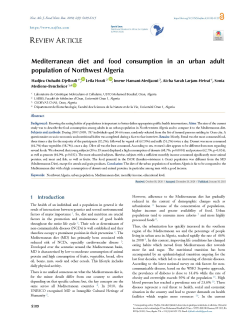Main Article Content
Mediterranean diet and food consumption in an urban adult population of Northwest Algeria
Abstract
Background:Knowing the eating habits of populations is important to better define appropriate public health interventions. Aims: The aim of the currentstudy was to describe the food consumption among adults in an urban population in North-western Algeria and to compare it to the Mediterranean diet. Subjectsand methods:During 2007-2009, 787 individuals aged 30-64 years, randomly selected from the list of insured persons residing in Oran city. A questionnaire on socio-economic and nutritional habits was completed during a face-to-face interview. Results:Mostly, Bread was the most consumed food, three times a day for the majority of the participants (92.2%), followed by vegetal oil (67.9%) and milk (51.2%) twice a day. Dessert was more consumed (64.7%) than vegetables (58.7%), once a day. Olive oil was the least consumed. According to sex, women’s diet appears to be different from men regarding several foods. We observed that young subjects (30 to 39 years) displayed a high consumption of desserts (68.7%, p<0.0001) and potatoes (62.7%, p=0.024), as well as peanuts (44.9%, p=0.032). The most educated subjects, likewise, subjects with a sufficient monthly income consumed significantly more animal pr oteins, red meat and fish, as well as fruits. The food pyramid in the ISOR (Insulino-résistance à Oran) population was different from the MD (Mediterranean Diet), except for cereals and grain products. Conclusion: The diet of the urban population of northern Algeria is far to be compared to the Mediterranean diet with a high consumption of desserts and animal proteins, in particular among men with a good income.







